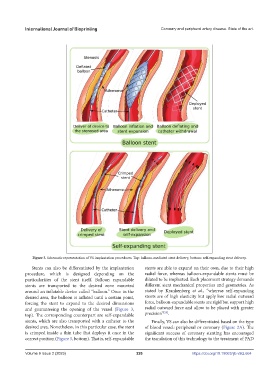Page 234 - IJB-9-2
P. 234
International Journal of Bioprinting Coronary and peripheral artery disease. State of the art.
Figure 3. Schematic representation of VS implantation procedures. Top: balloon-mediated stent delivery; bottom: self-expanding stent delivery.
Stents can also be differentiated by the implantation stents are able to expand on their own, due to their high
procedure, which is designed depending on the radial force, whereas balloon-expandable stents must be
particularities of the stent itself. Balloon expandable dilated to be implanted. Each placement strategy demands
stents are transported to the desired zone mounted different stent mechanical properties and geometries. As
around an inflatable device called “balloon.” Once in the stated by Krankenberg et al., “whereas self-expanding
desired area, the balloon is inflated until a certain point, stents are of high elasticity but apply low radial outward
forcing the stent to expand to the desired dimensions force, balloon-expandable stents are rigid but support high
and guaranteeing the opening of the vessel (Figure 3, radial outward force and allow to be placed with greater
[20]
top). The corresponding counterpart are self-expandable precision” .
stents, which are also transported with a catheter to the Finally, VS can also be differentiated based on the type
desired area. Nonetheless, in this particular case, the stent of blood vessel: peripheral or coronary (Figure 2A). The
is crimped inside a thin tube that deploys it once in the significant success of coronary stenting has encouraged
correct position (Figure 3, bottom). That is, self-expandable the translation of this technology to the treatment of PAD
Volume 9 Issue 2 (2023) 226 https://doi.org/10.18063/ijb.v9i2.664

